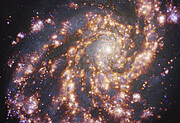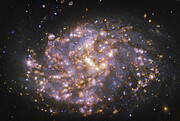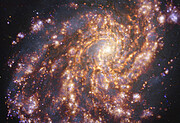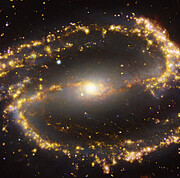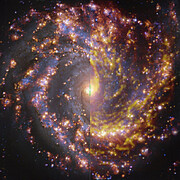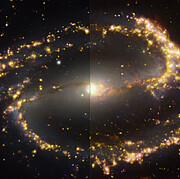Lehdistötiedote
Galaktista ilotulitusta: ESO:n uudet kuvat ovat paljastaneet lähigalakseista uusia piirteitä
16. heinäkuuta 2021
Tähtitieteilijöiden ryhmä on julkaissut uusia havaintoja läheisistä galakseista, joiden kuvat muistuttavat värikkäitä kosmisia ilotulituksia. Euroopan Eteläisen Observatorion (ESO) Very Large Telescope (ESO:n VLT) kaukoputkella otetuissa kuvissa näkyy värikkäitä galaksien osia, jotka paljastavat nuorten tähtien sijainnit ja niiden ympärillä olevan kaasun. Yhdistämällä nämä uudet havainnot Atacama Large Millimeter/submillimeter Array (ALMA)-järjestelmän havaintoihin (ESO on ALMA:n yhteistyökumppani) tutkimusryhmä pystyi saamaan uutta tietoa siitä, miten kaasusta muodostuu uusia tähtiä.
Tähtitieteilijät tietävät, että tähdet ovat syntyneet kaasupilvissä, mutta se mikä saa tähtien muodostumisen loppumaan, ja se miten galaksit kokonaisuutena ovat siinä mukana ovat edelleen mysteereitä. Tämän prosessin ymmärtämiseksi tutkijaryhmä on havainnut lähellä olevia galakseja tehokkailla maassa ja avaruudessa olevilla teleskoopeilla kartoittaen galaksien tähtiensyntyalueita.
”Ensimmäistä kertaa pystymme erottamaan yksittäisiä tähtien muodostumisen alueita hyvin erilaisissa paikoissa ja ympäristöissä laajassa otoksessa, jossa on mukana hyvin erilaisia galakseja”, Eric Emsellem, Saksan ESO tähtitieteilijä ja artikkelin pääkirjoittaja, sanoi. Tämä laaja kartoitus on tehty osana Physics at High Angular resolution in Nearby GalaxieS (PHANGS) projektia. ”Pystymme suoraan havaitsemaan tähtiä synnyttävää kaasua, ja näemme suoraan nuoria tähtiä ja pystymme havaitsemaan niiden kehityksen eri vaiheita”.
Emsellem (toinen affiliaatio on Lyonin yliopisto Ranskassa) ja hänen tutkimusryhmänsä ovat nyt julkaisseet uusimmat galaktiset kartoitukset, jotka on tehty Multi-Unit Spectroscopi Explorer eli MUSE-instrumentilla ESO:n VLT:llä Atacaman autiomaassa Chilessä. He käyttivät MUSE:a vastasyntyneiden tähtien ja niiden ympärillä olevan lämpimän kaasun havainnoissa. Tähdet valaisevat ja kuumentavat kaasua ja ne toimivat jatkuvan tähtien muodostumisen moottoreina.
Uudet MUSE:n kuvat yhdistettiin ALMA:n avulla aikaisemmin otettujen ja tänä vuonna julkaistujen kuvien kanssa. ALMA sijaitsee myös Chilessä, ja se sopii erityisen hyvin kylmien kaasupilvien kartoittamiseen, jotka ovat sellaisia galaksien osia, joissa on tähtiä muodostavaa raaka-ainetta.
Yhdistämällä MUSE:n ja ALMA:n kuvat tähtitieteilijät voivat tutkia niitä galaktisia alueita, joissa tähtien muodostuminen tapahtuu sen sijaan, että tilannetta tarkasteltaisiin vain teoreettisesti. Kuvien yhdistämisen avulla voidaan paremmin ymmärtää, mikä saa aikaan, tehostaa tai estää uusien tähtien syntymän. Lopputuloksena on upeita kuvia, jotka antavat värikkään näkymän naapurigalaksiemme tähtien lastentarhoihin.
”On monia mysteereitä, joita haluamme tutkia”, Kathryn Kreckel Saksan Heidelbergin yliopistosta ja myös yksi artikkelin kirjoittajista, sanoi. ”Syntyvätkö tähdet useammin emogalakseidensa tietyillä alueilla, ja jos näin on, niin miksi? Entä miten tähtien syntymisen jälkeen niiden evoluutio vaikuttaa uusien tähtien muodostumiseen?”
Tähtitieteilijät pystyvät nyt vastataamaan näihin kysymyksiin PHANGS-tiimin saamien MUSE- ja ALMA-datojen ansiosta. MUSE havaitsee spektrejä, jotka ovat kohteiden ”viivakoodeja”, joita tähtitieteilijät skannaavat paljastaakseen kosmisten kohteiden ominaisuuksia ja selvittääkseen niiden ominaispiirteitä. MUSE pystyy havaitsemaan spektrin jokaisessa paikassa näkökenttänsä sisällä. Näin se kerää paljon enemmän tietoa kuin perinteiset instrumentit. PHANGS-hanketta varten MUSE havaitsi 30000 lämpimän kaasun sumua ja keräsi noin 15 miljoonaa spektriä eri galaktisilta alueilta. Toisaalta ALMA-havainnot antoivat tähtitieteilijöille mahdollisuuden kartoittaa noin 100000 kylmän kaasun aluetta 90 lähigalaksin alueelta. Ne ovat tuottaneet läheisen maailmankaikkeuden ennennäkemättömän tähtien lastentarhan kartaston.
PHANGS-hankkeessa on ALMA:n ja MUSE:n lisäksi hyödynnetty NASA/ESA Hubble -avaruusteleskoopin havaintoja. Juuri nämä havaintolaitteet valittiin, jotta tutkimusryhmä voisi havaita galaktisia naapurejamme eri aallonpituuksilla (näkyvä, lähi-infrapuna ja radio). Jokainen aallonpituusalue paljastaa galakseista eri osia. ”Havaintojen yhdistämisen avulla voimme tutkia tähtien syntymän eri vaiheita tähtien lastentarhojen muodostumisesta itse tähtimuodostuksen alkamiseen ja edelleen vasta syntyneiden tähtitarhojen viimeiseen tuhoon. Tämä voidaan tehdä tarkemmin kuin yksittäisillä havainnoilla pystytään”, yksi artikkelin kirjoittajista Francesco Belfiore InaF-Arcetrista Firenzestä, Italiasta, sanoi. ”PHANGS on ensimmäinen hanke, jossa pystymme muodostamaan näin täydellisen näkymän näihin tapahtumiin. Voimme ottaa tarpeeksi teräviä kuvia nähdäksemme yksittäiset pilvet, tähdet ja tähtiä muodostavat sumut.”
PHANGS-hankkeessa tehtyä työtä parannetaan entisestään tulevien kaukoputkien ja instrumenttien avulla, kuten Nasan James Webb -avaruusteleskoopilla. Näin kerätty data luo perustan ESO:n Erittäin suuren teleskoopin (ELT) tuleville havainnoille. ELT aloittaa toimintansa myöhemmin tällä vuosikymmenellä ja se mahdollistaa tähtien lastentarhojen rakenteiden tarkemman tutkimisen.
”Niin hämmästyttävää kuin PHANGS onkin, tuottamiemme karttojen resoluutio riittää vain tunnistamaan ja erottamaan yksittäisiä tähtiä muodostavat pilvet, mutta ne eivät ole tarpeeksi hyviä, jotta pilvien sisällä olevat tapahtumat pystyttäisiin näkemään yksityiskohtaisesti”, Eva Schinnerer totesi. Hän on myös Max Planck Institute for Astronomy instituutin tutkimusryhmän johtaja Saksassa ja PHANGS-hankkeen päätutkija, jonka puitteissa uudet havainnot on tehty. ”Tiimimme ja muiden tutkimusryhmien uudet ponnistelut siirtävät havaintojen rajaa tähän suuntaan, joten edessä on jännittävien löytöjen vuosikymmen.”
Lisätietoa
Kansainvälisessä PHANGS-ryhmässä on mukana yli 90 tutkijaa maisteriopiskelijoista eläkeläisiin 30:stä instituutista kaikilta neljältä mantereelta. MUSE:n dataredusointityöryhmää PHANGS:issa johtaa Eric Emsellem (European Southern Observatory, Garching, Saksa ja Centre de Recherche Astrophysique de Lyon, Université de Lyon, ENS de Lyon, Saint-Genis Laval, Ranska) ja siinä mukana ovat Francesco Belfiore (INAF Osservatorio Astrofisico di Arcetri, Florence, Italia), Guillermo Blanc (Carnegie Observatories, Pasadena, US), Enrico Congiu (Universidad de Chile, Santiago, Chile and Las Campanas Observatory, Carnegie Institution for Science, Atacama Region, Chile), Brent Groves (The University of Western Australia, Perth, Australia), I-Ting Ho (Max Planck Institute for Astronomy, Heidelberg, Saksa [MPIA]), Kathryn Kreckel (Heidelberg University, Heidelberg, Saksa), Rebecca McElroy (Sydney Institute for Astronomy, Sydney, Australia), Ismael Pessa (MPIA), Patricia Sanchez-Blazquez (Complutense University of Madrid, Madrid, Espanja), Francesco Santoro (MPIA), Fabian Scheuermann (Heidelberg University, Heidelberg, Saksa) ja Eva Schinnerer (MPIA).
Siirry ESO:n julkiseen kuva-arkistoon nähdäksesi otoksen PHANGS-kuvista.
ESO on Euroopan johtava hallitustenvälinen tähtitieteen organisaatio ja ylivoimaisesti maailman tieteellisesti tuotteliain tähtitieteellinen observatorio. ESO:lla on 16 jäsenmaata: Alankomaat, Belgia, Espanja, Iso-Britannia, Italia, Itävalta, Irlanti, Portugali, Puola, Ranska, Ruotsi, Saksa, Suomi, Sveitsi, Tanska ja Tšekin tasavalta, joiden lisäksi Chile toimii laitteistojen sijoitusmaana ja Australia strategisena kumppanina. ESO toteuttaa kunnianhimoista ohjelmaa, joka keskittyy tehokkaiden maanpäällisten havaintovälineiden suunnitteluun, rakentamiseen ja käyttöön. Välineiden avulla tähtitieteilijät voivat tehdä merkittäviä tieteellisiä löytöjä. ESO:lla on myös johtava asema tähtitieteen tutkimuksen kansainvälisen yhteistyön edistämisessä ja organisoinnissa. ESO:lla on Chilessä kolme ainutlaatuista huippuluokan observatoriota: La Silla, Paranal ja Chajnantor. ESO:lla on Paranalilla VLT-teleskooppi (Very Large Telescope) ja siihen liittyvä, maailmanlaajuisesti johtava VLTI-interferometri, sekä kaksi kartoitusteleskooppia. VISTA toimii infrapuna-alueella ja VST-teleskooppi näkyvän valon aallonpituuksilla. Paranalilla ESO tulee myös hallinnoimaan ja operoimaan eteläistä Tšerenkov-teleskooppien verkostoa (Cherenkov Telescope Array South), joka on maailman suurin ja herkin gammasäteilyä havainnoiva observatorio. ESO on myös merkittävä kumppani kahdessa Chajnantorin laitteistossa, APEX-teleskoopissa ja ALMA-teleskoopissa, joka on maailman suurin tähtitieteellinen projekti. Lähellä Paranalia sijaitsevalla Cerro Armazonesilla ESO rakentaa 39-metrin kokoista ELT-teleskooppia (Extremely Large Telescope), josta tulee “maailman suurin tähtitaivasta havainnoiva silmä”.
Linkit
- PHANGS-verkkosivu
- MUSE-instrumentti
- VLT:n kuvia
- ALMA:n kuvia
- Median edustaja: Tilaa uutiskirje saadaksesi julkaisusulun alaiset uutiset omalla kielelläsi!
- Tutkijat: Onko sinulla kerrottavaa? Pitchaa oma tutkimuksesi!
Yhteystiedot
Eric Emsellem
European Southern Observatory
Garching bei München, Germany
Puh.: +49 89 3200 6914
Sähköposti: eric.emsellem@eso.org
Eva Schinnerer
Max Planck Institute for Astronomy
Heidelberg, Germany
Puh.: +49 6221 528 294
Sähköposti: schinner@mpia.de
Kathryn Kreckel
Astronomisches Recheninstitut, Zentrum für Astronomie, Universität Heidelberg
Heidelberg, Germany
Sähköposti: kathryn.kreckel@uni-heidelberg.de
Francesco Belfiore
INAF Osservatorio Astrofisico di Arcetri
Florence, Italy
Sähköposti: francesco.belfiore@inaf.it
Bárbara Ferreira
ESO Media Manager
Garching bei München, Germany
Puh.: +49 89 3200 6670
Matkapuhelin: +49 151 241 664 00
Sähköposti: press@eso.org
Pasi Nurmi (Lehdistön yhteyshenkilö Suomi)
ESO Science Outreach Network
ja University of Turku
Turku, Finland
Puh.: +358 29 4504 358
Sähköposti: eson-finland@eso.org
Tiedotteesta
| Tiedote nr.: | eso2110fi |
| Nimi: | NGC 1087, NGC 1300, NGC 3627, NGC 4254, NGC 4303 |
| Tyyppi: | Local Universe : Galaxy : Type : Spiral Local Universe : Galaxy : Type : Barred |
| Facility: | Atacama Large Millimeter/submillimeter Array, Very Large Telescope |
| Instruments: | MUSE |
Our use of Cookies
We use cookies that are essential for accessing our websites and using our services. We also use cookies to analyse, measure and improve our websites’ performance, to enable content sharing via social media and to display media content hosted on third-party platforms.
ESO Cookies Policy
The European Organisation for Astronomical Research in the Southern Hemisphere (ESO) is the pre-eminent intergovernmental science and technology organisation in astronomy. It carries out an ambitious programme focused on the design, construction and operation of powerful ground-based observing facilities for astronomy.
This Cookies Policy is intended to provide clarity by outlining the cookies used on the ESO public websites, their functions, the options you have for controlling them, and the ways you can contact us for additional details.
What are cookies?
Cookies are small pieces of data stored on your device by websites you visit. They serve various purposes, such as remembering login credentials and preferences and enhance your browsing experience.
Categories of cookies we use
Essential cookies (always active): These cookies are strictly necessary for the proper functioning of our website. Without these cookies, the website cannot operate correctly, and certain services, such as logging in or accessing secure areas, may not be available; because they are essential for the website’s operation, they cannot be disabled.
Functional Cookies: These cookies enhance your browsing experience by enabling additional features and personalization, such as remembering your preferences and settings. While not strictly necessary for the website to function, they improve usability and convenience; these cookies are only placed if you provide your consent.
Analytics cookies: These cookies collect information about how visitors interact with our website, such as which pages are visited most often and how users navigate the site. This data helps us improve website performance, optimize content, and enhance the user experience; these cookies are only placed if you provide your consent. We use the following analytics cookies.
Matomo Cookies:
This website uses Matomo (formerly Piwik), an open source software which enables the statistical analysis of website visits. Matomo uses cookies (text files) which are saved on your computer and which allow us to analyze how you use our website. The website user information generated by the cookies will only be saved on the servers of our IT Department. We use this information to analyze www.eso.org visits and to prepare reports on website activities. These data will not be disclosed to third parties.
On behalf of ESO, Matomo will use this information for the purpose of evaluating your use of the website, compiling reports on website activity and providing other services relating to website activity and internet usage.
Matomo cookies settings:
Additional Third-party cookies on ESO websites: some of our pages display content from external providers, e.g. YouTube.
Such third-party services are outside of ESO control and may, at any time, change their terms of service, use of cookies, etc.
YouTube: Some videos on the ESO website are embedded from ESO’s official YouTube channel. We have enabled YouTube’s privacy-enhanced mode, meaning that no cookies are set unless the user actively clicks on the video to play it. Additionally, in this mode, YouTube does not store any personally identifiable cookie data for embedded video playbacks. For more details, please refer to YouTube’s embedding videos information page.
Cookies can also be classified based on the following elements.
Regarding the domain, there are:
- First-party cookies, set by the website you are currently visiting. They are stored by the same domain that you are browsing and are used to enhance your experience on that site;
- Third-party cookies, set by a domain other than the one you are currently visiting.
As for their duration, cookies can be:
- Browser-session cookies, which are deleted when the user closes the browser;
- Stored cookies, which stay on the user's device for a predetermined period of time.
How to manage cookies
Cookie settings: You can modify your cookie choices for the ESO webpages at any time by clicking on the link Cookie settings at the bottom of any page.
In your browser: If you wish to delete cookies or instruct your browser to delete or block cookies by default, please visit the help pages of your browser:
Please be aware that if you delete or decline cookies, certain functionalities of our website may be not be available and your browsing experience may be affected.
You can set most browsers to prevent any cookies being placed on your device, but you may then have to manually adjust some preferences every time you visit a site/page. And some services and functionalities may not work properly at all (e.g. profile logging-in, shop check out).
Updates to the ESO Cookies Policy
The ESO Cookies Policy may be subject to future updates, which will be made available on this page.
Additional information
For any queries related to cookies, please contact: pdprATesoDOTorg.
As ESO public webpages are managed by our Department of Communication, your questions will be dealt with the support of the said Department.



